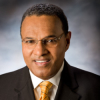Freeman A. Hrabowski III

Freeman A. Hrabowski III
Freeman Alphonsa Hrabowski III is a prominent American educator, advocate, and mathematician. In May 1992 he began his term as president of the University of Maryland, Baltimore County, one of the twelve public universities comprising the Maryland university system. Hrabowski has transformed a no-name, commuter university into a research institution recognized as one of the most innovative in the country. His administration continues to build a campus that’s first-rate in research and instruction, and that prepares students of all backgrounds...
NationalityAmerican
ProfessionEducator
Date of Birth13 August 1950
CountryUnited States of America